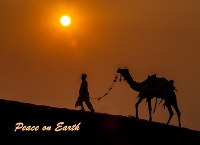.jpg)
Nomad on the Horseback
The lifestyle of Mongolian nomads is firmly rooted in the past – but they in no way eschew modern comforts. Herding sheep and cattle may be easier on horseback, but a shiny new bike is handy for the trips to the nearest (distant) town.
Think of Mongolia, and you think of nomads.
Nomads on horseback, driving their herds of goats, sheep, cattle and horses across the vast, rugged expanses of Central Asia, are still an important feature of the Mongolian landscape. In spite of a 2.78% annual rate of urbanisation (according to the CIA World Factbook), Mongolia still has one of the smallest urban populations in the region, and the nomadic idea is an integral part of the national psyche.
About 30% of Mongolians are nomadic or semi-nomadic, spending at least their summers in their portable ger housing close to their animals’ grazing lands, and living much as they have for hundreds of years. The herds live off the land, and the nomads live off the milk, meat and skins of their livestock. Fermented mare’s milk – airag – is popular, and milking the horses is one of the many daily activities (see: From Kharkhorin To Tariat).
This is not to say that nothing has changed.
Thanks to the advent of solar panels, between 60 and 70 percent of the nomadic population now has access to electricity for their mobile phones, radios, televisions, and electric lights. Children generally study in the cities, many at boarding schools, returning to their families’ ger camps during the summer. While horse culture is still central to nomadic life (Mongolia is home to more horses than people), reliance on horseback is reduced by motorcycles and trucks.
I was crossing the Mongolian steppes with a small group of photographic enthusiasts, under the leadership of local guides G and Segi, and photographers Jeffrey Chapman and Winslow Lockhart from Within the Frame. We had spent most of the long day before bumping along in our Russian UAZ (Ulyanovsky Avtomobilny Zavod) four-wheel-drive vehicles (see: Tosontsengel to Har Termes Uul), so it was a great relief when on this – our fifth day on the steppes – we pulled in to visit a family of nomads.
Do come along!
.jpg)
Hut on the Lakefront
We started our day across the road from the popular summer destination, Khyargas Lake – deserted in the late-September low-season.
.jpg)
Unbelievably Rustic!
To call our hotel rustic is to give it too much credit! I’m not sure what the outdoor ‘pool’ is about; there are no toilets or running water inside. (iNstagram)

Cabins on Khyargas Lake
The cabins across the road – presumably also without plumbing – have far more charm. (iNstagram)

Mountains in the Distance
Snow-capped mountains float in the distance as we continue our drive west, …

Gatekeepers Cottage
… stopping at the boom gate …

Ulaangom
.. before driving into Ulaangom (Улаангом: Red Valley), the local provincial capital, just 120 kilometres (70 m) south of the Russian border. We stopped for supplies – including sweets for the family of nomads we were about to visit. (iPhone6)

Nomad’s Ger
A traditional ger (Mongolian; yurt in Turkic languages) is a round tent covered with skins and felt used as a portable home by nomads in the steppes of Central Asia. Today their construction might include plastic tarps, and their transport from one place to another is more likely to be by truck rather than by ox cart.

Children of the Ger
It was unclear to me how many families were gathered in the ger, …

Child of the Ger
… but there were three or four young children in the group.

Inside the Ger
Inside the home is remarkably spacious. The central stove for heating and cooking has warm fermented mare’s milk, or airag, on it. This is served with yak butter in it. Not my favourite drink – it tastes a bit like warm yogurt.

Sewing Circle
A group of women has gathered in the ger to sew pelts together.

Hands at Work
With their leather thimbles, the women work quickly …

Sewing Skins
… putting together a patchwork of beautifully soft cashmere (otherwise called pashmina) goat pelts.

Nomadic Woman

Mother and Son
Mum, in traditional clothing, sits in front of a very-modern power-storage system.

Mum and Toddler
This little urchin already has a mouthful of the candies we have brought with us on our guide’s advice.

Nomadic Man and Child

Nomadic Man
Back outside, a man in his traditional deel overcoat and heavy boots …

Nomadic Man
… poses for pictures.

Mongolian Nomad

Mongolian Ponies
“A Mongol without a horse is like a bird without the wings.”
The rugged local horses are central to Mongolian nomadic culture.

A Man and his Horse
Every member of the family is likely to have their own favourite animal.
 We said our farewells, returned to our trucks and continued across the open plains westward …
We said our farewells, returned to our trucks and continued across the open plains westward …
… day-dreaming about almost-wild Mongolian ponies.


























.png)
.png)

